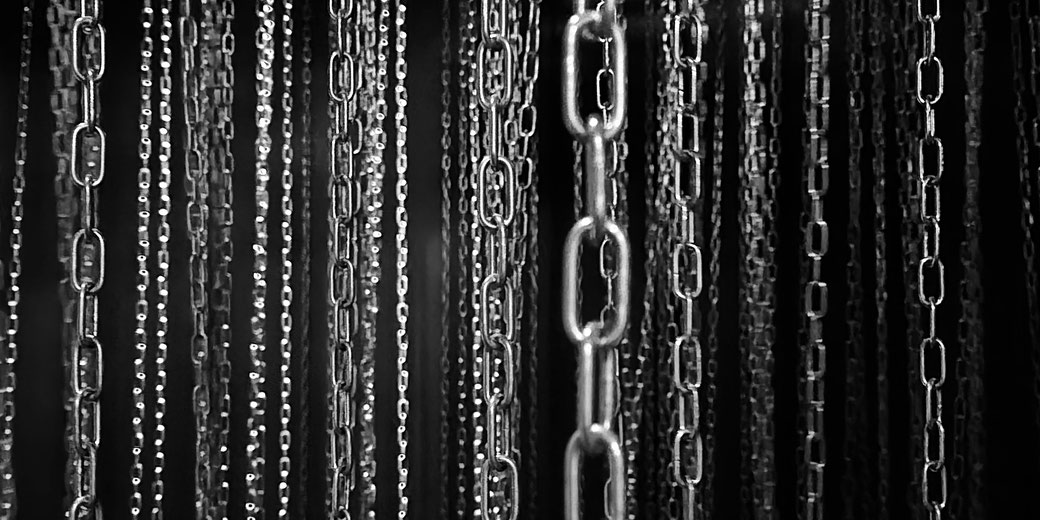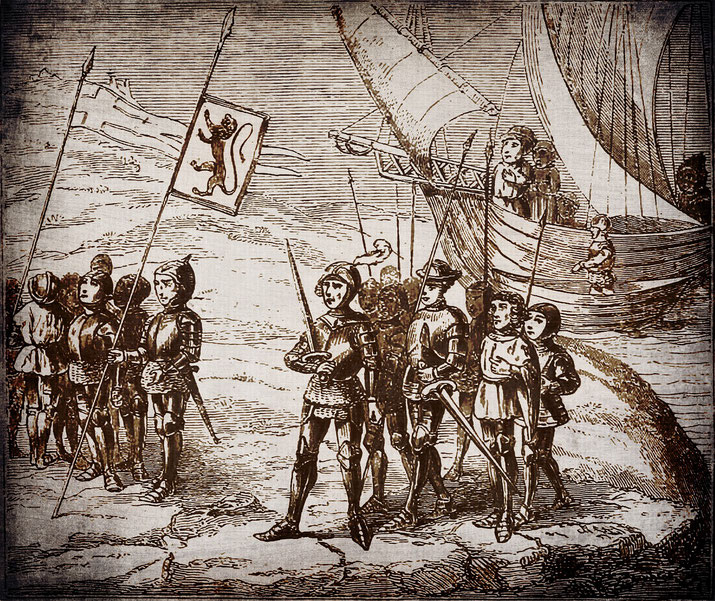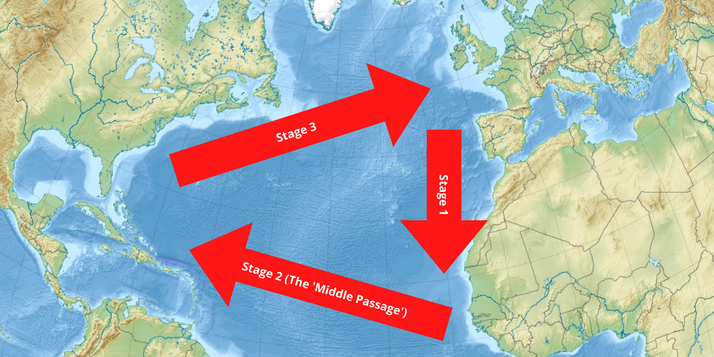Economics of inhumanity: How the transatlantic slave trade shaped three continents

During the 15th to the 19th century, merchants from Europe used captured millions of African people to sell as slaves in America by sailing them across the Atlantic Ocean.
This was due to the fact that as European nations expanded their colonial empires in the Americas, they relied on this human cargo to fuel economic growth.
As a result, the trade in human beings, known as the transatlantic slave trade, made America and Europe wealthy, but damaged millions of Africans lives, as well as their communities in Africa.
A brief history of slavery
The act of slavery was not a new phenomenon in the early modern period, as the capture and sale of other human beings had existed in many cultures throughout human history.
Even in the most well-known ancient cultures, such as Greece and Rome, the buying and selling of people was central to the economic growth of these cultures.
Similarly, slavery also existed among the different people groups on the African continent.
What was different about the transatlantic slave trade was the vast scale involved.
Not only were the sheer number of people captured and sold much higher, but the distances they were transported was further than had been attempted before.

What were the causes of the slave trade?
The transatlantic slave trade began in the 15th century when explorers from the European country of Portugal arrived in western Africa.
They had begun sailing south, along the coast of Africa, while trying to find a sea-route to India.
A number of these Portuguese explorers kidnapped local African people and took them back to Europe as slaves.
While the number of African people that were initially captured was relatively low, it did give birth to the idea that Africa was an ideal source of slaves in the future.
After Christopher Columbus' voyages to the Americas, which began in 1492, the Spanish and other European countries quickly colonised large parts of the New World.
The process of conquest had devastated the indigenous cultures and communities of the Americas, and their population numbers declined rapidly.
The Spanish had been hoping to use the Indigenous Americans as free labour or slaves for their colonies, but there were no longer enough people to achieve this.
Therefore, a solution was proposed to the growing labour shortage in the Americas: Europeans could simply import African slaves to the Americas instead.
As a result, the Spanish began transporting Africans to the Americas in the early 16th century, with the first recorded shipment arriving in 1518.
Most of these enslaved people came from the west coast of Africa, from the areas of modern Nigeria and Cameroon.
Later on, others were taken from other areas along the West African coast, including modern-day Ghana, Senegal, and Angola.
Subsequently, over the next four hundred years, over twelve million Africans would be taken and sold in this manner.

How and why Africans were captured
Seeing a new opportunity for making money, businessmen in European countries like Portugal, Spain, and Britain, became slave traders (also known simply as 'slavers').
Slave traders were wealthy people who bought sailing ships that were used solely for trading purposes.
These ships had large storage areas that would be filled either with tradable goods, or human slaves.
The earliest European slave traders simply arrived unannounced on the coast of Africa and sent out soldiers to physically capture any nearby Africans they could find and imprison them on the ships waiting off the coast.
However, the African people quickly realised what was happening and learnt to avoid the ships.
Therefore, the slave traders had to develop new tactics. This meant sometimes tricking victims onto their ships by pretending to trade with them.
Once more, when people realised that those people who stepped onto the ships never came back, the local people avoided them.
Finally, slavers made business deals with the leaders of particular African tribes. As part of these deals, these local leaders agreed to attack enemy people groups and trade any captives to the Europeans in return for expensive products, like clothes and weapons.
The fact that some African tribes captured other Africans and profited from the slave trade themselves often seems confusing to modern minds.
However, there are a number of reasons that tribal chiefs may have done this.
Firstly, slavery had been part of traditional African society before Europeans arrived.
Just like other human societies, it had been used as a form of punishment for people who had committed crimes or used as a way to pay off personal or family debts.
Also, enslaving people who had been captured during wartime as a form of payment to soldiers was common.
So, selling these captives on to Europeans in return for payment could be a natural progression of thought.
Also, these tribal leaders saw European merchants as an important way of increasing their own power over their local rivals.
The slave traders were offering to sell them the latest weapons technology and luxury goods, which could be used to raise their personal power and influence.
Therefore, it was an economically attractive option to sell their captives in return for these valuable commodities.
Finally, leaders of different people groups may have participated in the slave trade as a way of protecting themselves.
It would have become obvious that the Europeans would take any Africans they could, so by agreeing to hand over their enemies in return for a promise that their own people would not be taken, would have been a preservation strategy.
Through these various means of capturing African people, the slave trade had become a huge industry.
European slave traders invested large sums of money into building prisons along the coast of Africa, where captives could be held until the slave ships arrived to pick them up.
While imprisoned, the African victims were often branded with a red-hot iron like cattle to indicate their slave status.
The triangular trade
The slave traders' primary concern was about making money. This is what made slaves such an attractive option for them: they didn't have to buy their victims, as capturing them was free.
Also, when they sold them in the Americas, they would receive very high prices, which meant that profits were guaranteed.
However, as business owners, the traders would be constantly looking for ways to increase their profits and lower their costs.
The main cost for traders was the money required to pay for the ships and the sailors as they travelled from Europe to Africa, from Africa to the Americas, and then back to Europe again.
This three-part journey could take four to six months at a time, which cost a lot of money.
Therefore, a number of slave traders worked out that if they had something to sell in each of the three locations, then each stage of the journey would make money to offset the costs involved.
On the first leg, from Europe to Africa, the ships were full of weapons and luxury goods from the factories of Britain to be given to the tribal leaders in return for slaves.
Elmina in modern-day Ghana and Luanda in Angola were among the most significant slave ports in Africa for the end of the first leg.
Then, on the second leg, from Africa to the Americas, the ships were filled with slaves to be sold the plantation owners.
Sugar plantations in the Caribbean, particularly in colonies like Jamaica and Barbados, became the primary destinations for African slaves due to the labor-intensive nature of sugar production and the enormous profits it generated for European colonists.
The slave traders would then buy the luxury products grown in Americas, such as sugar, coffee, tobacco, and cotton, to fill their ships on their journey home, which was the third leg.
Once back in Europe, these products were sold in order to buy more weapons and luxury goods to begin the first leg again.
This three-stage journey was known as the 'triangular slave trade', as it roughly created the shape of a triangle as these ships travelled on their journey across the Atlantic Ocean.

The 'Middle Passage'
The most notorious part of the triangular transatlantic slave trade was the ship journey from the coast of Africa to the Americas.
This stretch of water was known as the 'Middle Passage' and was particularly brutal for the victims.
Since the slave traders' main aim in selling other humans was to make as much money as possible, they treated the captive Africans as 'things' rather than people.
On the coast of Africa, the ships would be filled with as many Africans as they could fit in, even if this meant that there was no room for them to move at all during the duration of the journey.
On some occasions, the captives were chained to the floor to limit the amount of space they took up.
This resulted in horrific conditions on slave ships, as injuries and diseases were commonplace.
Despite the terrible conditions, many Africans did survive to reach the Americas, where they faced further hardships.
Historians estimate that only three quarters of those that entered a ship in Africa exited it in the Americas.
Those that didn't reach their destination may have died from disease or starvation, been killed by the harsh treatment by the ship's crew or were simply thrown overboard if the slave traders needed to reduce numbers.
Some of the imprisoned people wanted to end their own lives rather than face this brutal journey.
They refused to eat, but the sailors would force food into their mouths to keep them alive.
What happened to the enslaved in the New World?
Once the slave ships reached the Americas, the slaves were then sold to landowners for use on their plantations.
Ninety percent of the people transported by the slave ships were sold in South America and the Caribbean, while around 4% ended up in North America.
European colonists in the New World were growing crops like sugar, cotton, and tobacco, which could be sold for huge profits.
However, these goods required a lot of manual labour to grow and harvest. Therefore, the farmers relied upon slave labour.
As the victims were slaves, they were not paid for their work, which meant that the landowners made a much larger profit when they sold their crops.
African slaves worked long hours, often for six days every week, and were forced to live in poor housing with limited food.
It was common for them to suffer significant injuries during their work or die due to starvation or beatings from their owners.
The higher the death rate, the higher the demand for more slaves, which only encouraged more slave traders to capture more Africans.
The long-term consequences of the slave trade
The removal of millions of people from the continent of Africa over 400 years devastated the growth and development of many parts of the continent.
This led to a decline in population growth, technological development, and standard of living.
By the time the European powers began colonising parts of Africa, the local kingdoms were already weakened, which made the process of colonisation easier.
In fact, back in 1526, King Afonso I of Kongo wrote a letter to the King of Portugal, protesting the devastating impact of the slave trade on his kingdom and requesting an end to the trade, though his pleas were ultimately ignored
By the 20th century, almost all of Africa had been claimed by European nations.
Also, the long-term impact of treating fellow humans of African descent as slaves continued to influence the thinking of many people of European descent in the Americas.
This led to laws that disadvantaged African Americans in particular in North America, even after the slave trade was formally abolished in the 19th century.
How slavers tried to dehumanize the enslaved
The practice of referring to the captured African people as 'slaves' was a deliberate practice to dehumanise them.
By doing so, slave traders attempted to identify them as 'items' that could be treated poorly without any moral qualms.
The more they were referred to as 'slaves', the easier it was to justify the horrific treatment of other human beings.
As a result, the more the people were dehumanised, the more the victims themselves were stripped of their personal identity.
It is important to remember that every one of the millions of victims was a real human being, who had hopes, dreams, challenges, families, and homes that were all stolen from them without any warning nor permission.
For example, they were farmers, businessmen, soldiers, religious leaders, craftspeople, husbands, wives, fathers, mothers, sons, and daughters.
They came from particular people groups with their own language, customs, and histories.
They lost contact with all of these things when they were sold and within a generation, the descendants of the victims had no clear knowledge of their heritage.
What do you need help with?
Download ready-to-use digital learning resources
Copyright © History Skills 2014-2025.
Contact via email
With the exception of links to external sites, some historical sources and extracts from specific publications, all content on this website is copyrighted by History Skills. This content may not be copied, republished or redistributed without written permission from the website creator. Please use the Contact page to obtain relevant permission.





